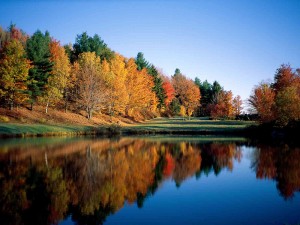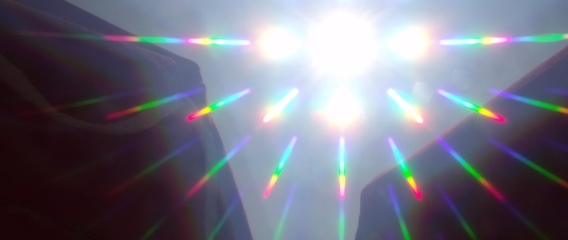Refraction!
As far as Touch Practice is concerned, I seem to have entered a period of profound reflection. At least that’s how I would describe it. Then a few weeks ago, one of my practice brothers and friends, a scientist, said, “I think you’re in a refractory period!” Hmmmm…..reflection or refraction? Time for me to run to my dictionary!
 Reflection, in the psychological realm, is “serious thought or consideration.” I suppose the definition of psychological reflection is based on the physical definition: “the throwing back by a body or surface of light, heat, or sound without absorbing it.” Self-reflection, in some sense, is taking a look at yourself, stepping away far enough that you can get a look without getting, well, self-absorbed. Maybe self-reflection is bouncing yourself off of yourself.
Reflection, in the psychological realm, is “serious thought or consideration.” I suppose the definition of psychological reflection is based on the physical definition: “the throwing back by a body or surface of light, heat, or sound without absorbing it.” Self-reflection, in some sense, is taking a look at yourself, stepping away far enough that you can get a look without getting, well, self-absorbed. Maybe self-reflection is bouncing yourself off of yourself.
 Refraction, (or a “refractory period,” in the world of my scientific friend), is “a period immediately following stimulation during which a nerve or muscle is unresponsive to further stimulation.” Well, yes. There has surely been some stimulation over these past six years and five hundred practice partners, so yes, perhaps there is a period of rest, a period “post-stimulation.” But I’m also struck by the definition of refraction as applied to light: the bending of light as it passes from one medium to another. One of my favorite places, you know, is “in between the worlds,” that magical space in the margins where we move from one arena to another. So, perhaps I’m in a refractory period, being bent and shaped, or perhaps I’m in a reflective period, simply looking at where I’ve been. One way or another, it’s been a time of passage, transformation, rest, and renewal.
Refraction, (or a “refractory period,” in the world of my scientific friend), is “a period immediately following stimulation during which a nerve or muscle is unresponsive to further stimulation.” Well, yes. There has surely been some stimulation over these past six years and five hundred practice partners, so yes, perhaps there is a period of rest, a period “post-stimulation.” But I’m also struck by the definition of refraction as applied to light: the bending of light as it passes from one medium to another. One of my favorite places, you know, is “in between the worlds,” that magical space in the margins where we move from one arena to another. So, perhaps I’m in a refractory period, being bent and shaped, or perhaps I’m in a reflective period, simply looking at where I’ve been. One way or another, it’s been a time of passage, transformation, rest, and renewal.
This seems like a particularly good time for summarizing. Where has Touch Practice taken me, where have we gone on this journey? Where have I been, and what’s up next? While Touch Practice is custom built for each person, it has taken me into four distinct groups of men, four little worlds, each world with specific, and different, interests in the work. The four groups I want to write about tonight are:
- men recovering from combat trauma (soldiers and military personnel)
- men recovering from childhood abuse (physical, emotional, or sexual)
- men who self-describe as having “unwanted same-sex attraction” (SSA)
- men who are actively exploring same-sex attraction, not necessarily sexually, but in ways which range from innocent, childlike curiosity all the way to intensely erotic engagement
Touch Practice and Soldiers
 The call to Touch Practice in the soldiers I have worked with tends to originate, almost inevitably, with combat trauma. Sometimes a man is traumatized by something he has witnessed or been part of peripherally, without actually coming into physical contact with the traumatic event. The contact may be visual, psychological, or energetic. Sometimes there is actual physical trauma to the body resulting in permanent injury, for example, paralysis or loss of a limb.
The call to Touch Practice in the soldiers I have worked with tends to originate, almost inevitably, with combat trauma. Sometimes a man is traumatized by something he has witnessed or been part of peripherally, without actually coming into physical contact with the traumatic event. The contact may be visual, psychological, or energetic. Sometimes there is actual physical trauma to the body resulting in permanent injury, for example, paralysis or loss of a limb.
The thing that took me some time to learn is that the energetic body does not “map” onto the same space that the physical body occupies; that’s true even of people who have not experienced body trauma. Sometimes a leg may be missing but there is intense energetic activity in the field formerly occupied by the leg. I suspect one of the things that is difficult for a person who is missing a limb is that while in some sense that part of the body is “gone,” in another sense it is very present, and negotiating between the two worlds to work with exactly what is “there” in that space can take some practice. A big part of sitting with someone who is missing a piece of their body or carrying an injury from which they will not recover is sitting with the energetic body, not the physical body, and working with it.
Soldiers are very solitary, in general. The Touch Practice I have done is inevitably individual, with great attention to privacy and secrecy, and they tend to refer each other. I did once work with a small group of soldiers on a base in the San Diego area doing very basic exercises in how to hold each other for “containment.” Touch Practice can be tremendously supportive as a physical expression of, quite simply, “I am here with you; I am surrounding you, containing you, and I am not going to let go.” If one can simply offer that, through touch, it’s surprising how often that is simply enough.
Touch Practice and Childhood Abuse
 This is an area where I have been very privileged to work, and it is a large part of the reason why I developed the work for myself. It has assisted me in reinvesting in and reinhabiting a body in which I had become unconfortable, but which now fits me like a favorite pair of jeans. The work with men who were physically, emotionally or sexually abused as children primarily revolves around boundaries. Oversimplifying, we establish a line that shouldn’t be crossed, and then we don’t cross it. We get as close as we possibly can without violating the space the other person has defined as safe. Often, for me, that involves holding a line that the other person has explicitly said they don’t want to cross, but then they attempt to cross it, repeatedly, while I persistently keep my half of the agreement. If the primary symbolism of the gesture to the soldier is, “I’m not going to leave you, I’m with you,” the primary gesture in this piece of the work tends to be, “I am not going to violate your space. The line that you drew for me? I’m going to stay on my side of the line.”
This is an area where I have been very privileged to work, and it is a large part of the reason why I developed the work for myself. It has assisted me in reinvesting in and reinhabiting a body in which I had become unconfortable, but which now fits me like a favorite pair of jeans. The work with men who were physically, emotionally or sexually abused as children primarily revolves around boundaries. Oversimplifying, we establish a line that shouldn’t be crossed, and then we don’t cross it. We get as close as we possibly can without violating the space the other person has defined as safe. Often, for me, that involves holding a line that the other person has explicitly said they don’t want to cross, but then they attempt to cross it, repeatedly, while I persistently keep my half of the agreement. If the primary symbolism of the gesture to the soldier is, “I’m not going to leave you, I’m with you,” the primary gesture in this piece of the work tends to be, “I am not going to violate your space. The line that you drew for me? I’m going to stay on my side of the line.”
Touch Practice and the SSA Community
 “SSA” refers to a movement of men who have what they self-describe as “unwanted same-sex attraction.” Unlike soldiers and abuse survivors, who tend to come to me as individuals and who are in general quite solitary and private about their experiences, the SSA community is a real community, with great, ginormous herds of men camping and backpacking and holding seminars and forming support networks. I often marvel how groups of SSA men and groups of gay men look almost exactly the same (the same networks, the same “support” intentionality, the same sense of being members of a tribe, the same love and commitment to each other as brothers.) At times the only difference I can find is that one group is happy to find sexual connection with each other and the other group is not, but beyond that, they are eerily identical in the psychodynamics of the group. When I do group workshops, SSA men and gay men mix together so perfectly that I often can’t guess which are which, and because the work isn’t sexual, I don’t need to.
“SSA” refers to a movement of men who have what they self-describe as “unwanted same-sex attraction.” Unlike soldiers and abuse survivors, who tend to come to me as individuals and who are in general quite solitary and private about their experiences, the SSA community is a real community, with great, ginormous herds of men camping and backpacking and holding seminars and forming support networks. I often marvel how groups of SSA men and groups of gay men look almost exactly the same (the same networks, the same “support” intentionality, the same sense of being members of a tribe, the same love and commitment to each other as brothers.) At times the only difference I can find is that one group is happy to find sexual connection with each other and the other group is not, but beyond that, they are eerily identical in the psychodynamics of the group. When I do group workshops, SSA men and gay men mix together so perfectly that I often can’t guess which are which, and because the work isn’t sexual, I don’t need to.
I’ve done SSA work both individually and in small groups, and the essential piece of the work for me has to do with creating the environment the person needs to feel safe so that they can get what they want without getting what they don’t want. Men in the SSA community want contact with men. They crave contact with men as much as any other community of men you can name, including gay men, but their ability to receive intimate contact from men will often shut down like a blast door if sexual feelings arise. For some SSA men, arousal is equated with moral failure, as though something went wrong. The work seems to revolve around paying very careful attention to the “erotic temperature,” helping them connect with their needs for affection, warmth and care while allowing a way for them to escape feelings that are more erotic or sexual. Some men in the SSA community are extremely comfortable with erotic or sexual feelings, but for many, those are scary enough that they’ll avoid even a simple hug, which leaves them undernourished in a really critical way. I try, in all cases, simply to give people what they think they need and keep them safe from anything they don’t feel ready to deal with. It’s hard to do perfectly. I try my best.
Men with wanted SSA!
 I often will lightheartedly contrast the “unwanted same sex attraction” community with the “wanted same sex attraction” crowd! This is not to say purely gay and bisexual men, but “men who love men” in all the many forms that manifests–fishing buddies, teammates in sport, those who are part of outdoors groups, men whose love takes many forms: platonic, fraternal, devotional, spiritual, and sexual.
I often will lightheartedly contrast the “unwanted same sex attraction” community with the “wanted same sex attraction” crowd! This is not to say purely gay and bisexual men, but “men who love men” in all the many forms that manifests–fishing buddies, teammates in sport, those who are part of outdoors groups, men whose love takes many forms: platonic, fraternal, devotional, spiritual, and sexual.
For men who experience the engagement of erotic energy with other men, Touch Practice can provide a way to explore that which is much deeper, often, than sex. Gay and bi men will often remark that Touch Practice is more intimate for them than many of the sexual experiences they’ve had, and I can understand how that could be. A focus on depth of connection is very different from a focus on “getting off,” almost a 180 degree difference in path. Touch Practice offers men who are curious about each others’ bodies, but who are not sexually attracted to men, a chance to explore the physical body with the same innocence we had as children. While we are taught “not to look” in the locker room, men have a natural curiosity about each others’ bodies which is not always sexually driven. It’s possible to be genuinely curious about what someone else’s penis looks like, or even feels like, without needing to have it in an orifice. I’m sorry if that sounds ridiculous, but it’s ridiculously true for many men. It’s an interesting part of the body.
So, at the risk of having stereotyped and generalized here, there are different populations that are curious about Touch Practice for different reasons and who come to the practice with very different intentions. Even while my own practice is to try to meet each man where he is, to offer him something truly handcrafted for his own experience, I think in some ways we learn from categorizing. We learn by saying, “this experience is a little bit like that other experience I had two weeks ago.” So while I try to sit with each soldier, or each SSA brother, or each gay person just for who they are, my experience with groups of people over time sometimes gives me a sense of what the landscape might be, what I might watch out for or expect, or what I might be prepared for. In the end, it’s about love, and love happens one person at a time, custom built, hand made.
 Brothers, let us love one another.
Brothers, let us love one another.
The next Touch Practicegroup retreat weekend will take place in Asheville, NC, March 14-16, 2014. Click here for registration information.














I was deeply moved by your examples of touch therapy. My first time hearing about this.
I want to see and hear about your future blogs, ideas, and practice!
Thank you Mark! Welcome to my site. Definitely keep an eye out for future blogs; meanwhile, you might find the “articles” section interesting because it has a summary of a lot of what I’ve learned. You can read more at https://touchpractice.com/articles/. Take care and thanks for writing me.
Well done, Kevin. Luvd it. New information for me.
Now I´ll go back to it and read the blue links.
Sweet!
All the good stuff is in the blue links! Thanks for reading!